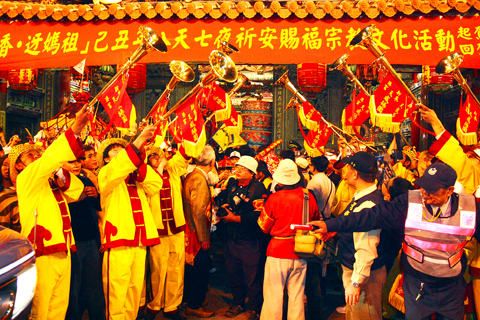Two temples in central Taiwan, separated by a river but consecrated to the same Chinese goddess — Matsu (媽祖) — have decided to end a six-decade dispute over which of them is the orthodox temple serving the former Benkang area.
Fongtian Temple (奉天宮) in Chiayi County’s Hsinkang Township (新港) and Chaotien Temple (朝天宮) in Yunlin County’s Peikang Township (北港) have not been on speaking terms for more than 60 years because the leaders of both temples have been unhappy with each other’s claim that they represent the area’s orthodox lineage in Matsu worship.
Fongtian Temple was built in 1700 in what was formerly the Bengang area, but was ruined by a flood in 1799. It was rebuilt at a different location in 1812 and became what it is today.

PHOTO: CNA
Chaotien Temple started in the 1690s as a small shrine in the same area and was expanded to a temple in the 1770s.
Flooding of the Beigang river in 1750 resulted in a topographical change and divided the former Benkang area into two parts, with Beigang township located on the north side of the river and Singang township on the south side.
The rivalry was aggravated 20 years ago when the famous Chenlan Temple in Tachia Township (大甲), Taichung County, stopped its annual pilgrimage to Chaotien Temple after welcoming a new Matsu statue from Meizhou in China’s Fujian Province. It now takes the statue on a visit to Fongtian Temple every April.
At a meeting on Jan. 22 shortly before the Lunar New Year, Ho Da-huang (何煌達), chairman of Fongtian Temple’s board of directors, and Tseng Tsai Mei-tso (曾蔡美佐), chairwoman of Chaotien Temple, reached a consensus on the need for mutual reconciliation between the temples.
With the blessings of their respective board members, Ho and Tsai agreed that worshipers at Fongtian Temple would take their Matsu statue on an “ice breaking” visit to Chaotien Temple.
The eight-day journey began on Saturday, and tomorrow the temples’ Matsu statues will meet in Chaotien Temple with worshipers from both temples burning incense together.
Matsu, worshipped as the goddess of the sea, is said to have been born in 960AD into a fisherman’s family in China’s Fujian Province in the Sung Dynasty and was given the name Lin Mo-niang (林默娘).
Legend says she had supernatural powers and had the ability to calm storms at sea. The numerous miracles attributed to her include rescuing sailors in distress and curing the sick with her vast knowledge of Chinese medicine.
Legend has it that at the age of 28, she told her parents it was time for her to leave them. After reaching the top of a mountain near her home, she was encircled by clouds and carried into heaven in a golden glow of light amid enchanting celestial music.
She was deified and referred to as Matsu, or maternal ancestor.
Residents of Taiwan’s offshore island Matsu (馬祖), however, have a different version of the story. They believe that she drowned while trying to rescue her father from a storm at sea and that her body was washed ashore on the island of Nangan (南竿).

US climber Alex Honnold is to attempt to scale Taipei 101 without a rope and harness in a live Netflix special on Jan. 24, the streaming platform announced on Wednesday. Accounting for the time difference, the two-hour broadcast of Honnold’s climb, called Skyscraper Live, is to air on Jan. 23 in the US, Netflix said in a statement. Honnold, 40, was the first person ever to free solo climb the 900m El Capitan rock formation in Yosemite National Park — a feat that was recorded and later made into the 2018 documentary film Free Solo. Netflix previewed Skyscraper Live in October, after videos

Starting on Jan. 1, YouBike riders must have insurance to use the service, and a six-month trial of NT$5 coupons under certain conditions would be implemented to balance bike shortages, a joint statement from transportation departments across Taipei, New Taipei City and Taoyuan announced yesterday. The rental bike system operator said that coupons would be offered to riders to rent bikes from full stations, for riders who take out an electric-assisted bike from a full station, and for riders who return a bike to an empty station. All riders with YouBike accounts are automatically eligible for the program, and each membership account

A classified Pentagon-produced, multiyear assessment — the Overmatch brief — highlighted unreported Chinese capabilities to destroy US military assets and identified US supply chain choke points, painting a disturbing picture of waning US military might, a New York Times editorial published on Monday said. US Secretary of Defense Pete Hegseth’s comments in November last year that “we lose every time” in Pentagon-conducted war games pitting the US against China further highlighted the uncertainty about the US’ capability to intervene in the event of a Chinese invasion of Taiwan. “It shows the Pentagon’s overreliance on expensive, vulnerable weapons as adversaries field cheap, technologically

NUMBERS IMBALANCE: More than 4 million Taiwanese have visited China this year, while only about half a million Chinese have visited here Beijing has yet to respond to Taiwan’s requests for negotiation over matters related to the recovery of cross-strait tourism, the Tourism Administration said yesterday. Taiwan’s tourism authority issued the statement after Chinese-language daily the China Times reported yesterday that the government’s policy of banning group tours to China does not stop Taiwanese from visiting the country. As of October, more than 4.2 million had traveled to China this year, exceeding last year. Beijing estimated the number of Taiwanese tourists in China could reach 4.5 million this year. By contrast, only 500,000 Chinese tourists are expected in Taiwan, the report said. The report